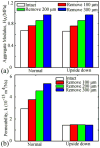A biphasic finite element study on the role of the articular cartilage superficial zone in confined compression
- PMID: 25465194
- PMCID: PMC4274183
- DOI: 10.1016/j.jbiomech.2014.11.007
A biphasic finite element study on the role of the articular cartilage superficial zone in confined compression
Abstract
The aim of this study was to investigate the role of the superficial zone on the mechanical behavior of articular cartilage. Confined compression of articular cartilage was modeled using a biphasic finite element analysis to calculate the one-dimensional deformation of the extracellular matrix (ECM) and movement of the interstitial fluid through the ECM and articular surface. The articular cartilage was modeled as an inhomogeneous, nonlinear hyperelastic biphasic material with depth and strain-dependent material properties. Two loading conditions were simulated, one where the superficial zone was loaded with a porous platen (normal test) and the other where the deep zone was loaded with the porous platen (upside down test). Compressing the intact articular cartilage with 0.2 MPa stress reduced the surface permeability by 88%. Removing the superficial zone increased the rate of change for all mechanical parameters and decreased the fluid support ratio of the tissue, resulting in increased tissue deformation. Apparent permeability linearly increased after superficial removal in the normal test, yet it did not change in the upside down test. Orientation of the specimen affected the time-dependent biomechanical behavior of the articular cartilage, but not equilibrium behavior. The two tests with different specimen orientations resulted in very different apparent permeabilities, suggesting that in an experimental study which quantifies material properties of an inhomogeneous material, the specimen orientation should be stated along with the permeability result. The current study provides new insights into the role of the superficial zone on mechanical behavior of the articular cartilage.
Keywords: Articular cartilage; Biphasic; Confined compression; Finite element analysis; Superficial zone.
Copyright © 2014 Elsevier Ltd. All rights reserved.
Conflict of interest statement
None
Figures







References
-
- Bonet J, Wood RD. Nonlinear continuum mechanics for finite element analysis. Cambridge University Press; Cambridge, UK: 1997.
-
- Chen A, Bae W, Schinagl R, Sah R. Depth-and strain-dependent mechanical and electromechanical properties of full-thickness bovine articular cartilage in confined compression. Journal of Biomechanics. 2001;34:1–12. - PubMed
-
- Clark JM. The organization of collagen in cryofractured rabbit articular cartilage: a scanning electron microscopic study. Journal of Orthopaedic Research. 1985;3:17–29. - PubMed
-
- Flannery CR, Hughes CE, Schumacher BL, Tudor D, Aydelotte MB, Kuettner KE, Caterson B. Articular cartilage superficial zone protein (SZP) is homologous to megakaryocyte stimulating factor precursor and is a multifunctional proteoglycan with potential growth-promoting, cytoprotective, and lubricating properties in cartilage metabolism. Biochemical and Biophysical Research Communications. 1999;254:535–541. - PubMed
-
- Gannon AR, Nagel T, Kelly DJ. The role of the superficial region in determining the dynamic properties of articular cartilage. Osteoarthritis and Cartilage. 2012;20:1417–1425. - PubMed
Publication types
MeSH terms
Grants and funding
LinkOut - more resources
Full Text Sources
Other Literature Sources

